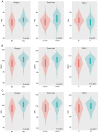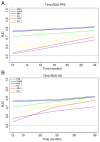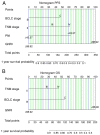Prognostic value of nutritional and inflammatory markers in patients with hepatocellular carcinoma who receive immune checkpoint inhibitors
- PMID: 37664652
- PMCID: PMC10472048
- DOI: 10.3892/ol.2023.14024
Prognostic value of nutritional and inflammatory markers in patients with hepatocellular carcinoma who receive immune checkpoint inhibitors
Abstract
The emergence of immune checkpoint inhibitors (ICIs) has provided a new treatment option for patients with hepatocellular carcinoma (HCC). However, further evaluation is needed for determining biomarkers for the use of ICIs. The present study evaluated the prognostic value of certain nutritional and inflammatory markers in patients with HCC who received ICIs. In the present study, the clinical data of 151 patients with HCC who received ICIs at Harbin Medical University Cancer Hospital from January 2019 to December 2021 were collected. The blood parameters of all patients before treatment were collected to evaluate certain nutritional and inflammatory markers, including the prognostic nutrition index (PNI), nutritional risk index (NRI), geriatric NRI (GNRI), systemic immune-inflammation index (SII), systemic inflammation response index (SIRI) and advanced lung cancer inflammation index (ALI). Patients were grouped using the cut-off value calculated using receiver operating characteristic (ROC) curves, and the relationship between these biomarkers and prognosis was evaluated through survival analysis. Furthermore, the prognostic value of these biomarkers was assessed through multivariate Cox regression analysis and construction of nomograms. Finally, time-ROC curves were plotted to compare the differences in predicting prognosis between the biomarkers. In the preliminary survival analysis, all inflammatory and nutritional markers included in the present study were significantly associated with the prognosis of HCC in patients who received ICIs. Similar results were obtained in a subgroup analysis of patients with different Barcelona Clinic Liver Cancer (BCLC) stages. Multivariate Cox regression analysis demonstrated that GNRI, PNI, BCLC stage and Tumor-Node-Metastasis (TNM) stage were significantly associated with progression-free survival (PFS), whereas GNRI, BCLC stage and TNM stage were also significantly associated with overall survival (OS). Furthermore, the time-ROC curves indicated that nutritional indicators had a higher prognostic value in all indexes, especially GNRI. The C-index (95% confidence interval) of the nomograms for predicting the survival probability of patients who received ICIs were 0.801 (0.746-0.877) and 0.823 (0.761-0.898) for PFS and overall OS, respectively, which also showed high accuracy. In conclusion, the present study demonstrated that PNI, GNRI, NRI, SII, SIRI and ALI were all related to the efficacy of ICIs in HCC and could serve as non-invasive biomarkers for ICI treatment effectiveness. Moreover, compared with inflammatory markers, nutritional markers had greater predictive ability, with GNRI being the biomarker with the best prognostic value.
Keywords: hepatocellular carcinoma; immune checkpoint inhibitors; inflammatory status; nutritional status; prognostic factors.
Copyright: © Liu et al.
Conflict of interest statement
The authors declare that they have no competing interests.
Figures










Similar articles
-
The combination of circulating IgM and geriatric nutritional risk index predicts the prognostic of hepatocellular carcinoma patients who underwent immune checkpoint inhibitors.Int Immunopharmacol. 2023 Oct;123:110704. doi: 10.1016/j.intimp.2023.110704. Epub 2023 Jul 26. Int Immunopharmacol. 2023. PMID: 37506504
-
Clinical significance of the combined systemic immune-inflammatory index and prognostic nutritional index in predicting the prognosis of patients with extensive-stage small-cell lung cancer receiving immune-combination chemotherapy.BMC Cancer. 2024 Dec 24;24(1):1574. doi: 10.1186/s12885-024-13343-x. BMC Cancer. 2024. PMID: 39719567 Free PMC article.
-
Correlation between preoperative systemic immune inflammation index, nutritional risk index, and prognosis of radical resection of liver cancer.World J Gastrointest Surg. 2023 Nov 27;15(11):2445-2455. doi: 10.4240/wjgs.v15.i11.2445. World J Gastrointest Surg. 2023. PMID: 38111765 Free PMC article.
-
Predictive value of the prognostic nutritional index in advanced non-small cell lung cancer patients treated with immune checkpoint inhibitors: A systematic review and meta-analysis.Heliyon. 2023 Jul 19;9(8):e17400. doi: 10.1016/j.heliyon.2023.e17400. eCollection 2023 Aug. Heliyon. 2023. PMID: 37520982 Free PMC article. Review.
-
Prognostic nutritional index as a prognostic biomarker for gastrointestinal cancer patients treated with immune checkpoint inhibitors.Front Immunol. 2023 Jul 21;14:1219929. doi: 10.3389/fimmu.2023.1219929. eCollection 2023. Front Immunol. 2023. PMID: 37545502 Free PMC article.
Cited by
-
The Gastric Cancer Immune Prognostic Score (GCIPS) Shows Potential in Predicting an Unfavorable Prognosis for Gastric Cancer Patients Undergoing Immune Checkpoint Inhibitor Treatment.Biomedicines. 2024 Feb 22;12(3):491. doi: 10.3390/biomedicines12030491. Biomedicines. 2024. PMID: 38540104 Free PMC article.
-
Prognostic Value of Blood-Based Inflammatory Markers in Cancer Patients Receiving Immune Checkpoint Inhibitors.Cancers (Basel). 2024 Dec 26;17(1):37. doi: 10.3390/cancers17010037. Cancers (Basel). 2024. PMID: 39796668 Free PMC article.
-
The prognostic value of systemic inflammation response index in digestive system carcinomas: a systematic review and meta-analysis.BMC Gastroenterol. 2025 Jan 24;25(1):34. doi: 10.1186/s12876-025-03635-2. BMC Gastroenterol. 2025. PMID: 39856542 Free PMC article.
-
Predictive Efficacy of the Advanced Lung Cancer Inflammation Index in Hepatocellular Carcinoma After Hepatectomy.J Inflamm Res. 2024 Aug 1;17:5197-5210. doi: 10.2147/JIR.S468215. eCollection 2024. J Inflamm Res. 2024. PMID: 39104905 Free PMC article.
-
Prognostic value of systemic immune-inflammation index/albumin ratio for immunotherapy-treated patients receiving opioids.PLoS One. 2024 Jun 27;19(6):e0305119. doi: 10.1371/journal.pone.0305119. eCollection 2024. PLoS One. 2024. PMID: 38935663 Free PMC article.
References
LinkOut - more resources
Full Text Sources
